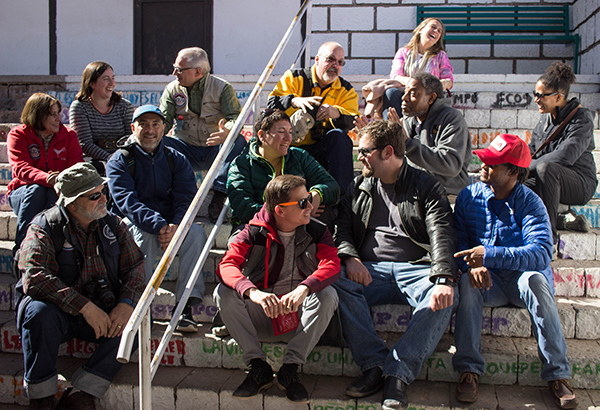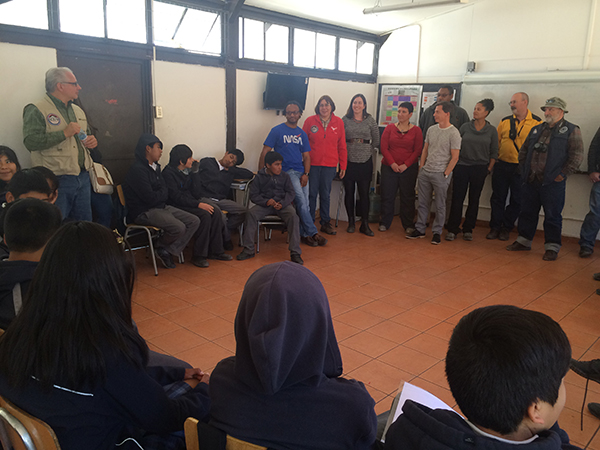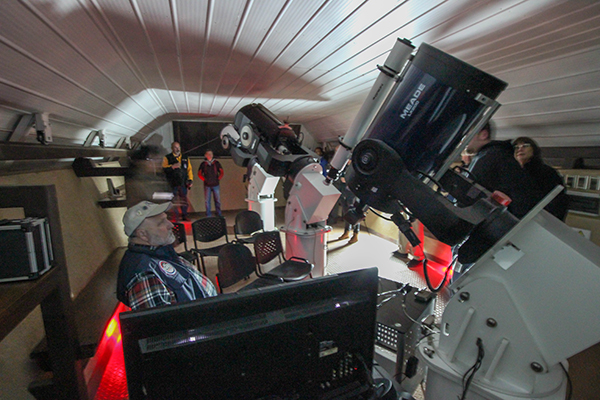New Astronomy Ambassadors-Educators Mission Land in Chile
A team of nine outreach and education professionals – eight from the United States and one from Chile – are undertaking a 10-day expedition to the Atacama Large Millimeter/submillimeter Array (ALMA) and other key astronomy research sites in Chile, as part of the Astronomy in Chile Educator Ambassadors Program (ACEAP). The program, now in its third year, is sponsored by the U.S. National Science Foundation (NSF).
The core element of ACEAP is an in-depth, behind-the-scenes tour of major NSF-funded observatories in Chile, including ALMA, the Cerro Tololo Inter-American Observatory (CTIO), the Southern Astrophysical Research (SOAR) telescope, and the Gemini South Observatory. In addition to learn about the different instruments, science, and research that comes out of these cutting-edge facilities, the ambassadors will also visit several smaller observatories that are open to the public.
“It’s important to keep the public informed and excited about basic research through astronomy,” said Tim Spuck, principal investigator for the ACEAP project and education officer for Associated Universities, Inc. “An informed society is the key to any successful undertaking, which is why we chose the most passionate professionals in astronomy. We want them to take away as much as they can experience during the program and share it with the world.”
ACEAP focuses on building a diverse and lasting community of educators who share their newfound knowledge and experiences with local communities through a range of informal science-education activities.



The 2017 class of ACEAP ambassadors includes:
• Angela Osterman Meyer, a high school science instructor at Culver Academies in Culver, Indiana;
• Ariel Hicks, an amateur astronomer and research assistant at the John Hopkins Center to Eliminate Cardiovascular Health Disparities in Baltimore, Maryland;
• Matthew Dieterich, an award-winning astrophotographer from Houston, Texas, whose photo was selected by the U.S. Postal Service as a stamp to commemorate the National Park Service Centennial;
• Amy Jackson, the founder and director of Starry Sky Austin and an astronomy educator for Travis Country Reimers Observatory, the University of Texas at Austin informal classes program, the Austin Independent School District, and a published author of a children’s book about the night sky;
• Ed Ting, an amateur astronomer from Manchester, New Hampshire, known for his writing and astrophotography featured in several astronomy magazines;
• Derek J. Demeter, the planetarium director of the Emil Buehler Planetarium at Seminole State College in Sanford, Florida, and president of the South-eastern Planetarium Association and Central Florida Astronomical Society;
• Alice Few, an institutional analyst for the University of Washington, astronomy faculty for Tacoma Community College, and volunteer with the Tacoma Astronomical Society and the Night Sky Network;
• Rich Lohman, an educator, amateur astronomer with Hands-On Universe, and founder of Over-The-Hill Observatory in Woodacre, California; and,
• María Rebeca López, a teacher with the Carlos Condell de La Haza School in La Serena, Chile, who has been leading the school in K-12 astronomy education for 19 years.
The nine ambassadors will be accompanied by Alison Klesman, an associate editor with Astronomy magazine in Waukesha, Wisconsin, as a media liaison.
The 2017 excursion started on June 18. You can follow their adventures on Facebook and Twitter at #ACEAP2017.
Additional information
The Astronomy in Chile Educator Ambassadors Program is a collaborative project of Associated Universities Inc., the National Radio Astronomy Observatory, the National Optical Astronomy Observatory (NOAO) and Gemini Observatory. NOAO and Gemini are both managed by Association of Universities for Research in Astronomy (AURA).
A list of the ambassadors from all three years of the program can be found here: https://epe.aui.edu/programs/astronomy-in-chile-educator-ambassadors-program/.
ALMA is a partnership of ESO (representing its member states), NSF (USA) and NINS (Japan), together with NRC (Canada), NSC and ASIAA (Taiwan), and KASI (Republic of South Korea), in cooperation with the Republic of Chile. The Joint ALMA Observatory is operated by ESO, AUI/NRAO and NAOJ.
Contacts
-
Nicolás Lira
Education and Public Outreach OfficerJoint ALMA Observatory, Santiago - ChilePhone: +56 2 2467 6519Cel: +56 9 9445 7726Email: [email protected]


